It’s a beautiful clear night. The stars are out and the Moon looks breathtaking against the sky, so you reach for your phone to take a snap. The results are, to be blunt, disappointing.
Try again. Steady your hands, focus on the Moon, take a photo and… it’s another underwhelming white smudge against a dark background. Hardly Instagram-worthy.
Phones often take superb photos, but why do they struggle with the Moon? It’s a little bit to do with what we are photographing, and a little bit to do with phone camera technology.
It’s not actually night
The first mistake novice astrophotographers make is assuming it is night time. Sure, it may be night time where you are on Earth but is it night time on the Moon?

M. J. I. Brown, CC BY
When you take a snap of the Moon, you are photographing its sunlit side. In other words, you are photographing broad daylight. Regardless of your camera, this means your settings should be similar to those for daytime photography rather than nighttime photography.

M. J. I. Brown, CC BY
Phones typically automate photography, including focus and exposure time. Unfortunately, this means that when the Moon is seen against a vast dark sky, the exposure time is set by the dark sky rather than the Moon. This means we turn the Moon into an overexposed bright smudge.
The easiest way to get around this problem is to photograph the Moon during the daytime. With a bright blue sky as the background (technically the foreground) your phone will use a suitably short exposure and you’ll likely get a better picture.
Another way to prevent over-exposed phone photographs is to dial down the exposure time manually, if you can.
So, you tried all that and the pics still look pretty average? Even with the right exposure time and good focus, phone photos of the Moon aren’t great and often don’t capture detail well.
This comes down to the design of phone cameras.
A wide view
Phones are great at taking photos of nearby objects (selfies, anyone?) and sweeping vistas. For example, some phones can take photos of the horizon that span from due north to due east – that’s a 90-degree field of view.
Unfortunately, the Moon (which is just half a degree across in the sky) gets lost in such an image. This comes down to the design choices that allow a camera to fit into a standard mobile phone.
Cameras and telescopes focus light coming from different directions onto detectors, be they old-fashioned photographic film or modern digital sensors with pixels.
The detail you see depends on the size of the pixels and the focal length; for a simple lens this is roughly the distance from the lens to the detector.
Phone camera lenses have focal lengths of a few millimetres, and the sensor pixels are thousandths of a millimetre in size. For a typical phone each pixel receives light from an angle of about 0.02 degrees – and since the Moon is 0.5 degrees across in the sky, its image ends up being only 25 pixels wide.
An image just 25 pixels wide is not going to have much detail. Phone camera software may add more pixels, attempt to sharpen the image or interpolate to add pixels, but this won’t add real detail to your Moon pic.
Zooming in and out
The obvious solution is to zoom in to get a more detailed image of the Moon.
For conventional cameras this is done with a zoom lens where the focal length can be increased (for example, from 50mm to 200mm). However, in phones the zoom is typically done digitally (in software) so the physical focal length is unchanged. Your disappointment will thus continue.
However, there is a solution. Why limit yourself to a phone camera lens?
Phones can take photographs with telescopes. Point a telescope at the Moon, hover your phone carefully above the eyepiece and you can get a remarkably good photo. This is because you’ve used the magnification of the telescope to effectively multiply the focal length of your camera.

M. J. I. Brown, CC BY
Instead of a 6mm focal length you may be working with 300mm. Instead of 25 pixels you may have 1,250 pixels. Now you can have great Moon photos.

M. J. I. Brown, CC BY
Phone photography using telescopes has really taken off over the past ten years. You can even get special clamps to hold your phone securely to a telescope.
But what if you don’t have a telescope handy? Well, instead of trying to zoom in, try zooming out. Remember that phones are great at taking in sweeping vistas.
Your phone may not be great at taking Moon photos, but it can take excellent photos of the Milky Way. And if you’re lucky, you can snap photos of rare visitors such as bright comets or auroras.